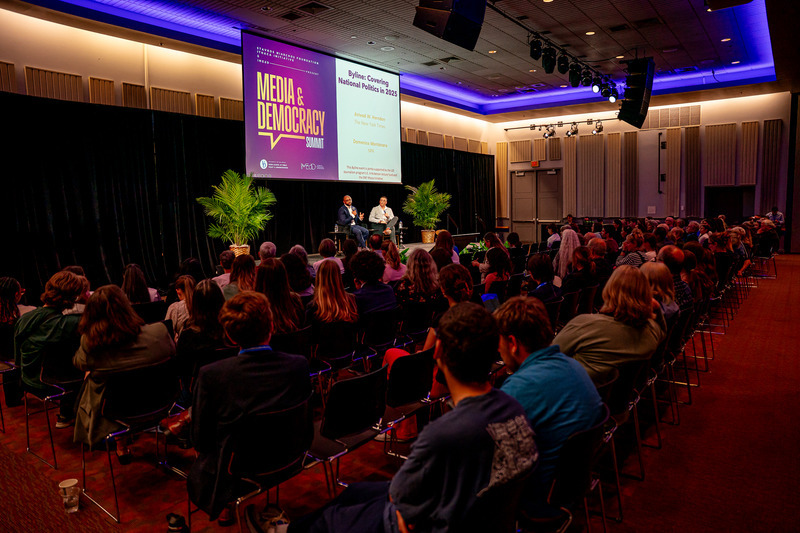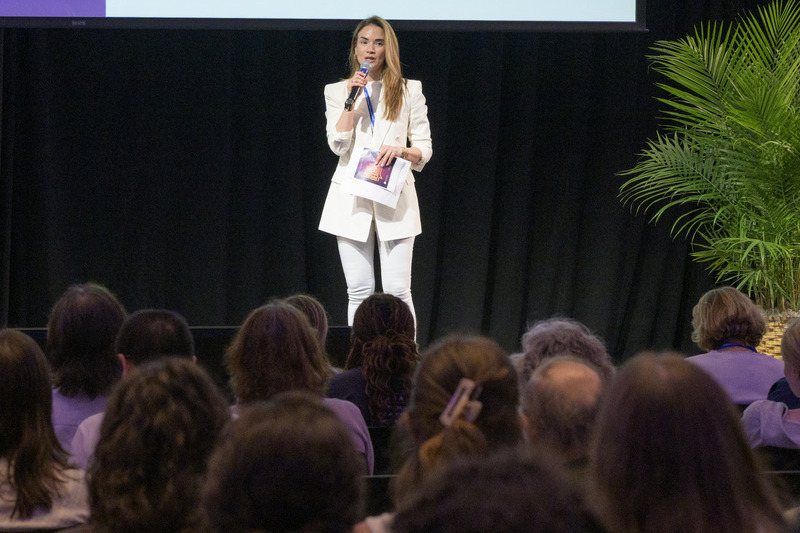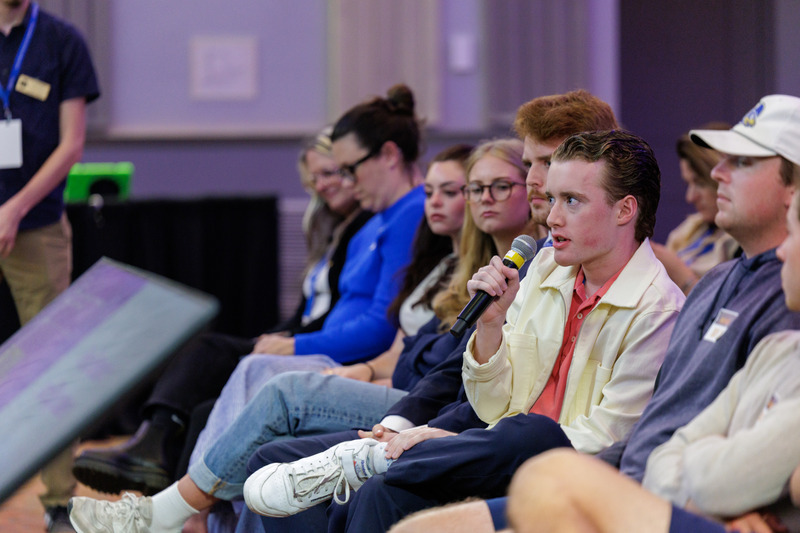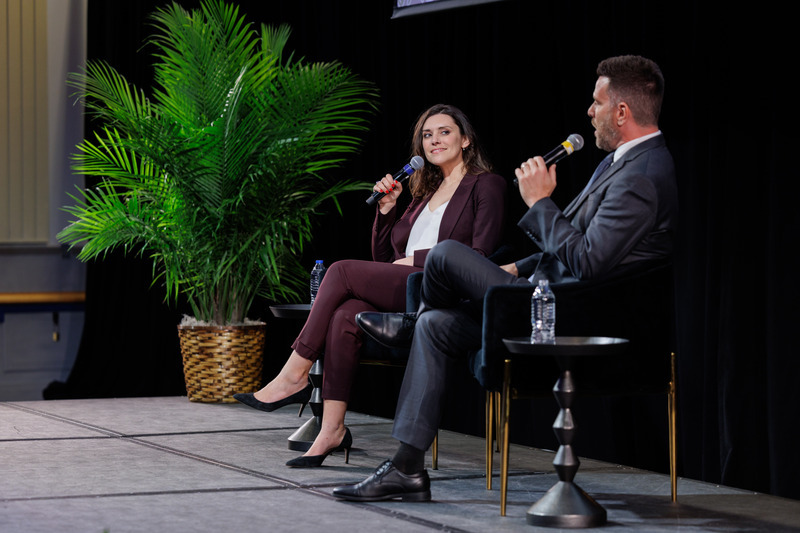


News at a crossroads
Photos by Kathy F. Atkinson and Mikey Reeves June 12, 2025
At the annual Media and Democracy Summit held at UD, diverse voices confront a growing crisis: the erosion of trust in media and its impact on democracy
The news is breaking. It is also, in the eyes of many, broken.
Without a healthy media ecosystem, much is at stake: our understanding of the world. Our ability to relate to one another. And, crucially, our power as citizens.
So, how did we get to this place? And where do we go from here?
Enter the SNF Ithaca x iMEdD Media and Democracy Summit, a free event held at the University of Delaware on May 5 and 6. Co-hosted by the Stavros Niarchos Foundation (SNF) Ithaca Initiative — based within UD’s Joseph R. Biden, Jr. School of Public Policy and Administration — and the nonprofit journalism organization iMEdD (incubator for Media Education and Development), the summit brought together leading scholars and journalists for a series of discussions on the challenges and opportunities facing both content creators and consumers. The stakes, the speakers agreed, have never been higher.
One of the summit’s central themes was the foundational role journalism plays in democratic societies — not as activism or profit-driven content, but as a public good.
“Journalism — this is something that I also mention very often — is not like activism, and it’s not like everything-for-profit. It’s a pillar of democracy, so somehow we have to figure out how this will work,” said Anna Kynthia Bousdoukou, co-founder and managing director of iMEdD.

Dimitris Bounias, a longtime journalist and iMEdD’s Director of Programs and Strategy, built on that idea: “Journalism is civic infrastructure, like roads, schools or clean water. Without it, democracy — and society — collapse.”
Or as Timothy Shaffer, Stavros Niarchos Foundation (SNF) Chair of Civil Discourse and director of the SNF Ithaca Initiative, put it: “How do we think more like journalists? How do we investigate, ask questions, and then communicate information that is authentic and true?”
Students weighed in to share their thoughts. A student-led panel, “College Students' Relationship with the Media,” highlighted the evolving ways young people engage with news and politics through both academic and social channels. Naomi Maria, an SNF Ithaca Student Leader, shared her journey from a politically homogenous area in the Bronx to a more ideologically diverse setting at UD, which challenged her biases and opened her up to a broader political understanding. Moderator and fellow SNF Ithaca Student Leader Isaac O’Neal referenced the Citizens, Civility, and Change course within the Biden School that encourages cross-political conversations among college students nationwide, questioning whether social media can be used to bridge such divides or if it inherently prevents constructive dialogue.

The student panel also addressed how media is consumed and produced on college campuses. Naija Agarwal, an SNF Paideia Fellow at the University of Pennsylvania, pointed out that news often breaks on platforms like Instagram, though social media remains an unreliable forum for meaningful conversation. Lauren Boyd, managing news editor for UD’s student newspaper, The Review, emphasized that growing up with technology has changed the nature of student journalism, where younger generations are both more reliant on the platform and less trusting of traditional outlets like college newspapers. Both she and Agarwal stressed the importance of accuracy and caution in reporting, particularly on sensitive topics like student visas, reflecting a growing awareness among student journalists of their ethical responsibilities in a digital-first media landscape.
Meanwhile, the threats to traditional media are great and varied. Panelists covered a range of factors responsible for the current crisis, including rising production costs and other economic pressures. This has led to a problematic consolidation of media companies. In turn, we are seeing a greater homogenization of news, with diverse perspectives increasingly difficult to come by and local outlets disappearing at warp speed.
“When these outlets go away, we see more corruption and more fiscal irresponsibility,” said Johanna Dunnaway, research director for the Institute of Democracy, Journalism and Citizenship at Syracuse University. “Basically, leaders don’t represent their constituents as well if they feel they’re unmonitored and unchecked by the press.”

In such an ecosystem, misinformation is rampant. And it’s fueled by social media algorithms that push users further — and deeper — into information silos.
“Lies travel faster than fact checks,” said Enrique Anarte Lazo, a multimedia journalist with the Thomson Reuters Foundation and co-presenter with Carmella Boykin of The Washington Post.
At the same time, reporters — once widely considered the watchdogs of truth and the arbiters of accountability — are under fire. Public faith in traditional media is at an all-time low thanks to a perfect storm of factors: a 24/7 news cycle that blurs the lines between facts and commentary, a woeful lack of media literacy within society, and missteps made by trusted outlets. Now, journalists must confront a difficult reality: Accuracy is no longer enough. At a time when resources are increasingly scarce, industry professionals must also work to build back eroded trust.
Many are rising to the challenge.
“I don’t work from the premise that the loss of trust is invalid,” said Astead W. Herndon, national politics reporter with The New York Times. “A lot of times, I agree with it. So I work to be a different type of proof point. I say, ‘You’re not talking to the Times; you’re talking to me. If you think there’s something we won’t print or say, try me.”

Gianluca Mezzofiore, editor of open-source investigations for CNN who uses visual forensics to debunk government propaganda, stressed the importance of transparency for connecting with his audience. He’s also a proponent of collaboration between competing outlets to boost accountability for reporters — and increase the shelf life of factual reporting.
“It can feel like trying to stop the tide; there is so much disinformation,” Mezzofiore said. “But I strongly believe in the resilience of this [news] community.”
A major source of public frustration with the media stems from underrepresentation — the idea that certain experiences or perspectives are not adequately covered on traditional platforms. As a result, many of the panelists are intentionally breaking these longstanding models in order to increase the reach — and impact — of news.
Take Rudy Fraser, a fellow in the Applied Social Media Lab at Harvard's Berkman Klein Center and founder of Blacksky, a social media platform designed with the needs of Black community members in mind. (Traditional platforms disproportionately censor Black users or even leave racist content unchecked.)
“If you create a space that’s safe for Black women — and trans folks, queer folks — then it’s generally safe for everyone,” Fraser said. “And once you create safety, people can experience joy.”
Then there’s Peter Bailey and Jed John Hope, the UD alumni behind Yellow Cedar Media, a company giving voice to the Virgin Islands where they grew up, because, Bailey said: “I got tired of being invisible.”
His advice to aspiring journalists?
“Get off your high horse,” said the former Miami Herald and Time magazine reporter. “Get down with the people you are covering. That creates a movement.”
Equally important for moving the needle on the media industry crisis: discussions like this. Hard conversations that intentionally bring together people with opposing views. The final panel of the series, on the intersection of free speech and big ideas, grew spirited as conservative political commentator David Rubin engaged independent investigative reporter Tara Palmeri of the Tara Palmeri Show. (“Just because you don’t like the source doesn’t mean it’s not a source,” the latter said at one point, during a discussion on the veracity of legacy news reporting.)
But even they found common ground: Traditional media will never be the same. A tidal change is underway.
That reality can either be terrifying — or transformative. If society has any hope of ushering in a better, less toxic media era, reporters, news consumers and fans of democracy will be well served by the advice of Jeralynn Miller, philanthropic strategist for NPR and proud UD graduate.
“Keep asking questions,” she told the crowd. “And keep going.”

Contact Us
Have a UDaily story idea?
Contact us at ocm@udel.edu
Members of the press
Contact us at mediarelations@udel.edu or visit the Media Relations website

